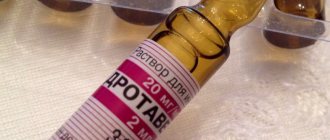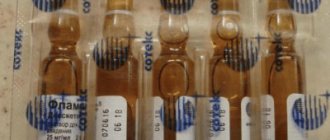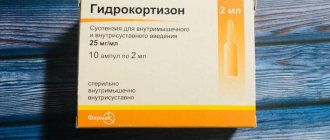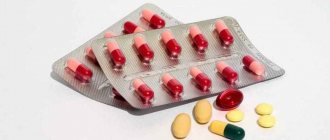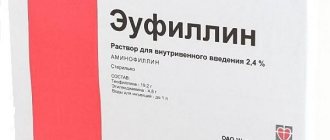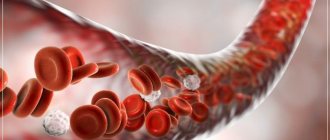Pharmacological properties of the drug Dexalgin
An NSAID that has analgesic, anti-inflammatory and antipyretic effects due to a decrease in prostaglandin synthesis due to inhibition of the COX system. After oral administration, the effect of the drug begins after 30 minutes and lasts 3–6 hours. The maximum concentration of the drug in the blood serum when taken orally is achieved on average after 30 minutes (15–60 minutes). The distribution time and half-life of dexketoprofen are 0.35 and 1.65 hours, respectively. Metabolized primarily through binding to glucuronic acid followed by excretion by the kidneys. Does not accumulate in the body.
Contraindications
Dexalgin is contraindicated if you are allergic to dexketoprofen or other non-steroidal anti-inflammatory drugs, as well as to any of the components.
Contraindicated in the presence of gastric or duodenal ulcers, primarily in the presence of anamnestic gastrointestinal bleeding, in case of other bleeding in the active stage (including suspected hemorrhagic stroke or subdural/epidural hematoma), in the case of ongoing anticoagulant therapy, in the presence of hemorrhagic diathesis and other disorders of the blood coagulation system.
Dexalgin is not used for Crohn's disease or ulcerative colitis. In case of existing severe dysfunction of the liver (score 10-15 points on the generally accepted Child-Pugh scale) and kidneys (creatinine clearance less than 50 ml per minute).
It is not used if the patient has aspirin-dependent bronchial asthma (including a history), severe heart failure, or for the treatment of pain during coronary artery bypass grafting.
Dexalgin is not used in pediatric practice.
Dexalgin is contraindicated in pregnant and lactating women. Due to the fact that Dexalgin contains ethanol, the drug is not used for neuraxial administration (intrathecal, epidural, intrathecal).
Use with caution if you have a history of allergic conditions; in cases of hematopoietic disorders; with systemic lupus erythematosus, mixed connective tissue diseases; if other medications are taken simultaneously, if there is a predisposition to hypovolemia; coronary heart disease is present; should be used with caution in people over 65 years of age.
Use of the drug Dexalgin
Depending on the intensity of the pain, a single dose of the drug is 12.5–25 mg every 8 hours. It is not recommended to take 75 mg (3 tablets) per day. Dexalgin is taken as needed and is not intended for long-term treatment. It is advisable to start therapy in elderly patients, with mild renal impairment, as well as with mild or moderate liver dysfunction with low doses (daily dose is 50 mg - 2 tablets). If well tolerated, the dose can be increased to the usual one.
Indications
Dexalgin is able to relieve pain of various origins. For example, with toothache, renal colic, in cases of post-traumatic, postoperative pain, as well as with sciatica, neuralgia, radiculitis, pain with metastases in the bones, in the case of algodismenorrhea.
As an anti-inflammatory agent, dexalgin is used to eliminate symptoms in both acute and chronic inflammatory diseases, as well as in cases of inflammatory-degenerative and metabolic disorders of the musculoskeletal system. For example, in the case of rheumatoid arthritis, spondyloarthritis, as well as arthrosis and osteochondrosis.
Side effects of the drug Dexalgin
Often (1–10% of cases) nausea and/or vomiting, abdominal pain, dyspepsia, diarrhea occur; in 0.1–1% of cases - weakness, increased fatigue, sleep disturbances, anxiety, fear, headache, dizziness, hot flashes, skin rash, palpitations, dry mouth, gastritis, constipation, bloating, in 0.01–0 .1% - paresthesia, increased blood pressure, peripheral edema, bradypnea, peptic ulcer, ulcer perforation, bleeding, anorexia, increased activity of liver enzymes, urticaria, increased sweating, polyuria, back pain, loss of consciousness, in women - menstrual irregularities, in men - dysfunction of the prostate gland. In isolated cases (≤0.01%), neutropenia, thrombocytopenia, visual impairment, tinnitus, tachycardia, hypotension, bronchospasm, shortness of breath, damage to the pancreas, liver, severe reactions from the skin and mucous membranes (Stevens-Johnson syndrome, Lyell's syndrome), vascular edema, photosensitivity skin reactions, skin itching, kidney damage (nephritis or nephrotic syndrome), anaphylactic reactions, angioedema of the face.
Dexalgin's analogs
There are no analogues of Dexalgin based on the active substance. Analogues of Dexalgin, according to their belonging to the same pharmacological group and mechanism of action, include:
- Advil;
- Algesir Ultra;
- Bonifen;
- Deblock;
- Ibuklin;
- Ketonal;
- Ketoprofen;
- MIG 400;
- Nalgesin;
- Nurofen;
- OKI;
- Teraflex Advance;
- Faspik;
- Flexen;
- Next;
- Nurofen Express;
- Ketoprofen Organics;
- Khairumat;
- Artrum;
- Vimovo;
- Nurofen Rapid Forte;
- Ibuprofen Sandoz.
Drug interactions Dexalgin
Combined use with other NSAIDs, oral anticoagulants, pentoxifylline is not recommended due to the increased risk of bleeding; with lithium preparations - due to a possible increase in the concentration of the latter in the blood and the development of its toxic manifestations; with methotrexate in high doses (15 mg/week) - due to an increase in its toxic effect on the blood. When used in combination, dexketoprofen may increase the toxicity of hydantoin and sulfonamides. Caution is required when used in combination with diuretics and ACE inhibitors - a weakening of the antihypertensive effect and/or development of acute renal failure is possible; with methotrexate in low doses (≤15 mg/week) - its hematotoxicity may increase; with zidovudine - possible inhibition of erythropoiesis; with sulfonylurea drugs - their hypoglycemic effect may be increased. It is necessary to take into account the possibility of weakening the antihypertensive effect of beta-adrenergic blockers; increased toxicity of cyclosporine and tacrolim, increased risk of bleeding when using thrombolytic drugs. Probenocid may increase the concentration of dexketoprofen in the blood.
special instructions
There are a number of special instructions that must be strictly followed.
It is prohibited to mix Dexalgin solution and solutions of drugs such as pethidine, dopamine, promethazine, hydroxyzine, pentazocine in one syringe, since such mixing causes the formation of a precipitate.
It is allowed to mix Dexalgin and a solution of drugs such as morphine, heparin, theophylline or lidocaine in one syringe.
A diluted solution of Dexalgin for infusion should not be mixed with solutions of promethazine or pentazocine.
It is acceptable to store diluted solutions of Dexalgin in a plastic container or when using infusion systems made from materials such as cellulose propionate, ethyl vinyl acetate, LDPE or PVC, since the active substance is not absorbed by these materials.
The following interactions are common to all NSAIDs. In particular, there are a number of undesirable combinations:
- Dexalgin and other NSAIDs, including salicylates in high doses (more than 3 grams per day), since when several NSAIDs are administered simultaneously, a synergistic effect appears, resulting in a higher risk of gastrointestinal ulcers and bleeding.
- Dexalgin with oral anticoagulants, as well as heparin, in doses higher than prophylactic, ticlopidine, in this case there is a higher risk of bleeding as a result of inhibition of platelet aggregation and damage to the gastrointestinal mucosa.
- Dexalgin and lithium preparations. Due to the fact that NSAIDs can increase the level of lithium in the blood up to toxic levels, this indicator is monitored both when prescribing or changing the dose, and after discontinuation of NSAIDs.
- With methotrexate in high doses (15 mg/week or more), there is an increase in the hematological toxicity of methotrexate due to a decrease in its renal clearance during therapy with any anti-inflammatory drugs.
- With hydantoins and sulfonamides, there is a risk of increased toxic effects of these drugs.
There are combinations that require caution when used:
- With diuretics, ACE inhibitors. In this case, during NSAID therapy there is a risk of developing acute renal failure in patients with dehydration (decreased glomerular filtration due to reduced PG synthesis). NSAIDs may reduce the hypotensive effect of some drugs. When co-prescribed with diuretics, make sure that the patient's fluid balance is not impaired, and monitoring of renal function is required before prescribing NSAIDs.
- With methotrexate in low doses (less than 15 mg per week), increased hematological toxicity of methotrexate is possible. Blood cell counts are required once a week during the first weeks of simultaneous use.
- Proper monitoring of the condition of elderly patients and patients with impaired renal function, including mild ones, is necessary.
- With pentoxifylline, the risk of bleeding is increased. Both clinical monitoring and continuous monitoring of blood clotting times should be carried out.
- Zidovudine may affect reticulocytes, resulting in a risk of increased red blood cell toxicity and severe anemia within a week of NSAID administration. In this case, it is necessary to count reticulocytes, as well as all blood cells, 1-2 weeks after the start of NSAID treatment.
- When using sulfonamide drugs and NSAIDs, the latter can enhance the hypoglycemic effect of sulfonylurea due to its displacement from sites of binding to plasma proteins.
- NSAIDs and low molecular weight heparin preparations – increased risk of bleeding.
There are also combinations that must be taken into account when treating with Dexalgin:
- With β-blockers, in this case NSAIDs can reduce the hypotensive effect of β-blockers, this is due to inhibition of PG synthesis.
- With cardiac glycosides, due to the fact that the use of NSAIDs increases the concentration of glycosides in the blood plasma.
- When carrying out simultaneous therapy with cyclosporine and tacrolimus, monitoring of renal function is required, since NSAIDs increase nephrotoxicity, which is mediated by the action of renal PGs.
- With thrombolytics, due to the increased risk of bleeding.
- When used with probenecid, an increase in the concentration of NSAIDs in plasma is possible, this may be due to an inhibitory effect on renal tubular secretion, as well as conjugation with glucuronic acid, resulting in the need for NSAID dosage adjustment.
- With mifepristone, there is a theoretical risk of changes in the effectiveness of mifepristone under the influence of PG synthesis inhibitors. NSAIDs are not prescribed earlier than 8-12 days after discontinuation of mifepristone.
- Caution is required when used with ciprofloxacin, since based on experimental studies in animals, the likelihood of developing convulsions has been identified when NSAIDs and ciprofloxacin are prescribed in high doses.
It should also be remembered that when using Dexalgin together with other drugs that affect blood clotting, careful medical supervision is required.
The use of Dexalgin can increase the level of creatinine and nitrogen in plasma. Dexalgin, like other inhibitors of PG synthesis, can have side effects on the urinary organs, which can result in the development of interstitial nephritis, glomerulonephritis, papillary necrosis, as well as a state of acute renal failure or nephrotic syndrome.
While taking Dexalgin, there may be a slight increase in some liver parameters, which subsequently disappears, as well as a significant increase in the levels of AST and ALT in the blood serum. In this case, it is necessary to monitor renal and hepatic functions in elderly patients. Cancellation required
Dexalgin with a significant increase in these indicators.
Dexalgin can mask the symptoms of infectious diseases. If signs of a bacterial infection are noticed, as well as if your health worsens during Dexalgin therapy, a doctor’s consultation is required.
Each ampoule of the drug contains 200 mg of ethyl alcohol.
When using Dexalgin, there is a possibility of dizziness, as well as a feeling of drowsiness, and therefore, patients may experience a decrease in attention and speed of psychomotor reactions.
How to store the drug
Dexalgin is dispensed in pharmacies only as prescribed by a doctor. Ampoules should be stored in a dark and cool place. Be sure to hide the product from children. Therefore, it is worth choosing closed premises for it. Avoid exposing the packaging to direct sunlight.
The prepared solution for injections and infusions can be stored for no longer than 2 hours. In the refrigerator, this time increases 12 times - up to 24 hours. If a smaller dosage is needed, then a new ampoule should be opened each time.
The shelf life of the drug is 5 years from the date of production - indicated on the packaging. Strict temperature conditions are required. The price of such a product is not the most budget-friendly - on average about five hundred rubles.
Composition and release form
Dexalgin is available in three formats: tablets, oral granules and injection solution. Their composition and packaging features:
| Granules | Solution | Pills | |
| Description | Yellow granules with lemon flavor and aroma | Clear liquid with the odor of alcohol | White round tablets |
| Dexketoprofen concentration, mg | 25 per 1 sachet | 25 per 1 ml (50 per 1 ampoule) | 25 per 1 piece. |
| Auxiliary components | Colloidal silica, ammonium glycyrrhizate, sucrose, neohesperedine dihydrochalcone, lemon flavor, quinoline yellow | Sodium hydroxide, ethanol, water, sodium chloride | Propylene glycol, microcrystalline cellulose, macrogol, corn starch, titanium dioxide, sodium carboxymethyl starch, hypromellose, glyceryl palmitostearate, glycerin |
| Package | 10 or 30 sachets per box with instructions for use | Ampoules of 2 ml, 1, 5 or 10 ampoules per pack | Blisters of 10 pcs., 1, 3 or 5 blisters per box |
Dexalgin price (where to buy)
The price of Dexalgin injections is about 100 UAH for 5 ampoules. On average, the price of Dexalgin tablets (25 mg) is 55 UAH per strip (10 tablets).
- Online pharmacies in RussiaRussia
- Online pharmacies in UkraineUkraine
ZdravCity
- Dexalgin granules for intravenous injection solution.
approx. 25 mg 10 pcs. Laboratorios Menarini S.A., Spain RUB 388 order - Dexalgin solution for in. 25mg/ml 2ml 10 pcs. Menarini Manufacturing Logistics and Services S.r.L.
520 rub. order
- Dexalgin tablets p.p.o. 25 mg 10 pcs. Laboratorios Menarini S.A./A. Menarini Manufacturing Logistics
RUB 302 order
- Dexalgin solution for in. 25mg/ml 2ml 5 pcs.A.Menarini Manufacturing Logistik and Servicer
RUB 236 order
Pharmacy Dialogue
- Dexalgin (solution IM, IV 25 mg 2 ml amp. No. 5) Berlin-Chemie AG/Menarini
RUB 262 order
- Dexalgin (tablet p/o 25 mg No. 10)Berlin-Chemie AG/Menarini
RUB 343 order
- Dexalgin (solution IM, IV 25 mg 2 ml amp. No. 10) Berlin-Chemie AG/Menarini
RUR 527 order
show more
Pharmacy24
- Dexalgin 50 mg/2 ml N5 solution for injection A. Menarini Manufacturing, Logistics and Services S.r.L., Italy
180 UAH.order - Dexalgin 25 mg No. 10 granules Laboratorios Menarini S.A., Spain
121 UAH order
- Dexalgin 25 mg No. 10 tablets A. Menarini Manufacturing Logistics and Services S.r.L./Laboratorios Menarini S.A., Italy/Spain
97 UAH order
Pharmacodynamics and pharmacokinetics
The drug is classified as a non-steroidal anti-inflammatory drug. The active substance dexketoprofen inhibits the cyclooxygenase and reduces the intensity of prostaglandin . Thus, within half an hour after taking the medicine, the pain subsides and the temperature decreases. The medicine exhibits an anti-inflammatory effect.
When taken orally , it reaches maximum concentration after 40 minutes. The half-life by the kidneys is up to 2 hours. About 99% of the substance binds to blood proteins. When taken simultaneously with food, the maximum concentration in the blood will be slightly lower and will take longer to reach its maximum value.
When intravenously and intramuscularly , the pharmacokinetics are the same as when taking tablets. The maximum concentration is reached within 10 minutes.
Description of the drug
Dexalgin, the instructions for use of which are simple and clear, is a non-steroidal anti-inflammatory drug. It is intended to have the following effects on the human body:
- Anesthesia;
- Elimination of inflammation;
- Antipyretic effect.
It works, like many other drugs, with prostaglandins - its task is to stop their production. After all, it is these substances and components that cause pain and fever. They are also quite capable of causing swelling, which further aggravates the situation.
The drug works quite quickly - so, after just half an hour you can feel the first effect: the condition is relieved and improved. The effect lasts for 4-8 hours, provided that the drug was taken at a dosage of 50 mg. If you use Dexalgin with various opioid-based analgesics, you can reduce the dosage of the latter.
Compound
One tablet of the drug contains dexketoprofen trometamol 0.0369 g (dexketoprofen 0.025 g) + excipients: corn starch, glycerin palmitostearate, microcrystalline cellulose, sodium carboxymethyl starch, titanium dioxide, propylene glycol, hypromellose, macrogol 6000.
Dexalgin Injection in 1 ampoule contains active substances dexketoprofen trometamol 0.0369 g or 0.0738 g + excipients: sodium chloride, water for injection, ethanol, sodium hydroxide.
Reviews for the drug
Dexalgin is an extremely effective drug that allows you to cope with pain and other negative consequences of a particular disease. Therefore, there are quite a lot of reviews about it on the Internet. For example, Nikolay499 notes that this remedy is the most powerful analgesic that he has used. The only downside he mentions is the high price of the drug. This remedy was prescribed to him at a doctor’s appointment after surgery - the user was tormented by abdominal pain. Various analogues, such as No-Shpa, Diclofenac, etc. didn't help. And the doctor advised Dexalgin. And this despite the fact that it should be used very carefully in those who suffer from various gastrointestinal pathologies. After the effect of the drug ended, the attack did not return, which means that Dexalgin completed its task.
Neo user notes that the drug did not work for her - it could not relieve her toothache. Among the minuses, the number of side effects was mentioned. The woman bought this drug on the recommendation of a doctor to get rid of toothache. Nise helped, but it was not sold without a prescription, so I decided to try another remedy. It had little effect.
User Npyul notes that this remedy is a good pain reliever, but has pronounced side effects. This drug is often taken for pain in the lower back and back. It has a fairly strong analgesic effect. Moreover, if you use it in injections, you should prepare for the fact that the injection will be painful. The presence of serious side effects scared the user, so despite the proven effect, she is not going to purchase it yet.
Overdose options
The dosage indicated in the annotation for Dexalgin should not be exceeded. If this is done even for a little while, signs and symptoms may appear such as:
- Nausea;
- Manifestations of anorexia;
- Abdominal pain;
- Pain in the head;
- Dizziness;
- Disorientation in space;
- Sleep disorders.
Treatment in this case is symptomatic. In some cases, gastric lavage may be required, and in particularly difficult situations, dialysis.
